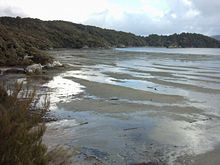Mudflat
Mudflats may be viewed geologically as exposed layers of bay mud, resulting from deposition of estuarine silts, clays and aquatic animal detritus.A recent global remote sensing analysis estimated that approximately 50% of the global extent of tidal flats occurs within eight countries (Indonesia, China, Australia, United States, Canada, India, Brazil, and Myanmar) and that 44% of the world's tidal flats occur within Asia (56,051 km2 or 21,641 sq mi).[4] In the past tidal flats were considered unhealthy, economically unimportant areas and were often dredged and developed into agricultural land.For example, the mudflats surrounding Anchorage, Alaska, are made from fine glacial-silt which does not easily separate out its water, and, although seemingly solid, can quickly gel and become like quicksand when disturbed by stepping on it.However, mudflats worldwide are under threat from predicted sea level rises, land claims for development, dredging due to shipping purposes, and chemical pollution.

Sand Flatsupratidalintertidalsubtidalintertidal zonebeach barrierlongshore currentscoastal wetlandsriversmangrovesbayouslagoonsestuariesfreshwatersalty lakescreeksgeologicallybay mudestuarinedetritusremote sensingIndonesiaAustraliaUnited StatesCanadaBrazilMyanmarAnchorage, AlaskaquicksandBaltic SeaGermanyWindwattStewart IslandNew Zealandsalt marshesmangroveecosystemsshorebirdsmigratory birdsmollusksUnited KingdomBiodiversity Action Plansea level risesdredgingchemical pollutionaquacultureagricultureYellow SeaBioturbationMarshesherbaceous plantsMudcracksSalt pansKneiss IslandsTunisiaSkagit BayWashingtonBrewster, MassachusettsWrack (seaweed)high-water markArcachon BayFranceBanc d'ArguinMauritaniaChamiza WetlandGreat Rann of KutchBelhavenEast LothianScotlandBridgwater BayMorecambe BayCape Cod BayMassachusettsCook InletAlaskaLindisfarne IslandEnglandMinas BasinNova ScotiaMoreton BayQueenslandNorth SlobWexfordIrelandKneiss ArchipelagoPadilla BayPlymouth BayPort of TacomaPort SusanWarm BeachSnettishamNorfolkWadden SeaNetherlandsDenmarkAndros Island, BahamasNorth KoreaSouth KoreaHerringbone cross bedsBibcodeCoastal geographyLandformsAnchialine poolArchipelagoAvulsionBarrier islandBoddenBrackish marshChannelCoastal plainCoastal waterfallContinental marginContinental shelfCoral reefcliff-topEstuaryFreshwater marshFundusHeadlandIntertidal wetlandIslandIsthmusLagoonMachairNatural archPeninsula